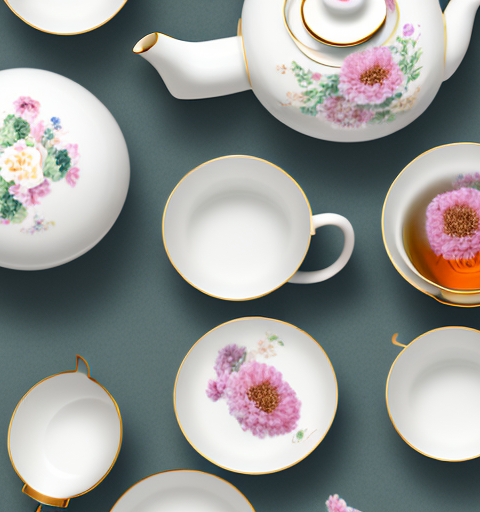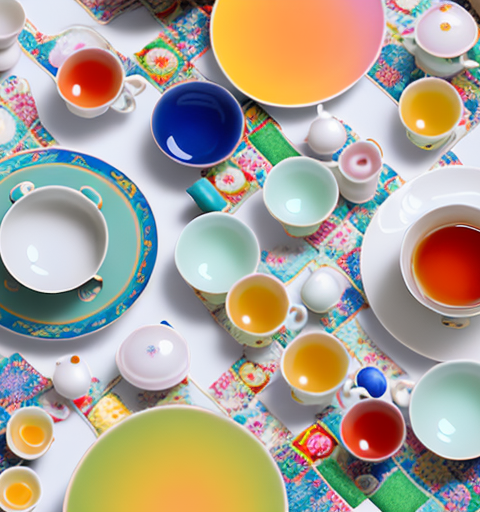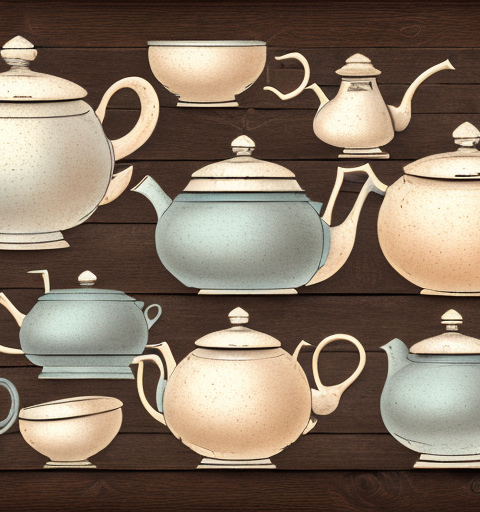Understanding the Different Types of Chinese Teas
Chinese teas come in a wide variety, each offering its own unique flavors and health benefits. Some popular types include green, black, oolong, white, and pu-erh teas. Green teas are known for their fresh, grassy flavor and high antioxidant content. Black teas have a rich, full-bodied taste and are often enjoyed with milk or sugar. Oolong teas are semi-oxidized and have a sweet and fruity flavor. White teas are delicate and subtly sweet, while pu-erh teas are aged and have a complex earthy taste.
In addition to these popular types of Chinese teas, there are also herbal teas that are widely consumed for their medicinal properties. Herbal teas, also known as tisanes, are made from various plants and herbs, such as chamomile, peppermint, and ginger. These teas are often caffeine-free and are known for their soothing and calming effects on the body.
Furthermore, Chinese tea culture is deeply rooted in tradition and has a long history dating back thousands of years. Tea ceremonies, known as gongfu tea, are an important part of Chinese culture and are often performed to showcase the art of tea preparation and appreciation. These ceremonies involve precise rituals and techniques, such as the use of special tea utensils and the pouring of tea in a specific manner, all aimed at enhancing the taste and aroma of the tea.
Exploring the Benefits of Brewing Chinese Teas
Brewing Chinese teas has numerous benefits for both body and mind. Firstly, the natural antioxidants found in these teas promote good overall health by protecting cells from damage and reducing the risk of chronic diseases. Secondly, the caffeine present in Chinese teas can provide an energy boost and increase mental alertness. Additionally, some Chinese teas have specific properties that aid in digestion, boost the immune system, and promote relaxation and better sleep.
Furthermore, brewing Chinese teas can be a meditative and calming practice. The process of preparing and steeping the tea leaves requires focus and attention, allowing individuals to slow down and be present in the moment. This can help reduce stress and promote a sense of relaxation and mindfulness.
In addition, Chinese teas offer a wide variety of flavors and aromas, making the brewing experience a sensory delight. From delicate floral notes to rich earthy flavors, there is a tea to suit every palate. Exploring the different flavors and experimenting with brewing techniques can be a fun and enjoyable way to expand your tea knowledge and appreciation.
Choosing the Right Teapot for Chinese Tea Brewing
When it comes to brewing Chinese teas, selecting the right teapot is crucial. Luckily, ceramic teapots are an excellent choice for brewing Chinese teas due to their versatility and heat retention properties. Ceramic teapots are known for their ability to distribute heat evenly, resulting in a well-balanced brew. They also do not absorb flavors, allowing you to enjoy the true essence of the tea without any interference.
In addition to ceramic teapots, another popular choice for brewing Chinese teas is Yixing teapots. Yixing teapots are made from a special type of clay found in the Yixing region of China. These teapots are highly regarded for their ability to enhance the flavors of the tea over time. The porous nature of the clay allows the teapot to absorb the oils and flavors of the tea, creating a unique and personalized brewing experience.
When choosing a Yixing teapot, it is important to consider the size and shape. The size of the teapot should be proportional to the amount of tea you plan to brew. A smaller teapot is ideal for brewing individual servings, while a larger teapot is suitable for brewing tea for a group. The shape of the teapot can also affect the brewing process. A teapot with a wide opening allows for better heat distribution, while a teapot with a narrow opening helps to retain heat for a longer period of time.
The Advantages of Using a Ceramic Teapot for Chinese Teas
In addition to their heat retention properties, ceramic teapots offer several advantages when brewing Chinese teas. Firstly, their natural material ensures that no harmful chemicals leach into the tea, maintaining its purity. Secondly, ceramic teapots have a classic and elegant design that enhances the tea drinking experience. Finally, their durability allows for long-term use, making them a worthwhile investment for tea enthusiasts.
Moreover, ceramic teapots are known for their ability to distribute heat evenly, which is crucial for brewing delicate Chinese teas. The even heat distribution ensures that the tea leaves are steeped at the optimal temperature, allowing for the full extraction of flavors and aromas. This results in a more flavorful and satisfying tea drinking experience.
Step-by-Step Guide to Brewing Chinese Teas in a Ceramic Teapot
To brew Chinese teas in a ceramic teapot, start by warming the teapot with hot water to ensure an optimal brewing temperature. Next, measure the desired amount of tea leaves and add them to the teapot. Pour hot water over the leaves and cover the teapot. Allow the tea to steep for the recommended duration, depending on the type of tea. Once the steeping time is over, pour the tea into cups and enjoy the rich flavors and aromas.
It is important to note that different types of Chinese teas require different water temperatures for brewing. For example, green teas are best brewed with water that is around 175°F (80°C), while black teas can be brewed with water that is around 195°F (90°C). Oolong teas, on the other hand, are typically brewed with water that is around 185°F (85°C). Adjusting the water temperature according to the type of tea will help bring out the best flavors and aromas in the brew. Additionally, it is recommended to use filtered or spring water for brewing Chinese teas, as the quality of water can greatly impact the taste of the tea.
Tips and Tricks for Getting the Perfect Brew with Your Ceramic Teapot
To maximize your tea brewing experience with a ceramic teapot, consider these helpful tips. Firstly, use fresh, filtered water to ensure the highest quality brew. Secondly, experiment with different tea-to-water ratios to find your preferred strength. Additionally, adjust the steeping time based on personal taste preferences. Finally, preheat your teacups to keep your tea warm for a longer period.
Another tip for getting the perfect brew with your ceramic teapot is to choose the right temperature for steeping. Different types of tea require different water temperatures to bring out their optimal flavors. For example, green tea is best steeped at a lower temperature, around 175°F (80°C), while black tea can be steeped at a higher temperature, around 200°F (93°C). It’s important to pay attention to the recommended steeping temperatures for the specific type of tea you are brewing.
In addition to temperature, the quality of the tea leaves also plays a crucial role in achieving a perfect brew. Opt for loose leaf tea instead of tea bags, as loose leaf tea generally offers a more flavorful and aromatic experience. When using loose leaf tea, make sure to use a tea infuser or a tea strainer to prevent the leaves from ending up in your cup. This will ensure a smoother and more enjoyable tea-drinking experience.
Common Mistakes to Avoid When Brewing Chinese Teas in a Ceramic Teapot
While brewing Chinese teas in a ceramic teapot is a straightforward process, certain mistakes can affect the final result. Avoid using boiling water, as it can scorch delicate tea leaves and result in a bitter taste. Similarly, oversteeping the tea can lead to a strong and overpowering brew. It is also important to clean your ceramic teapot regularly to prevent the buildup of tea residue and maintain its optimal performance.
Another common mistake to avoid when brewing Chinese teas in a ceramic teapot is using tap water that contains high levels of chlorine or other impurities. These impurities can negatively impact the flavor and aroma of the tea. To ensure the best brewing experience, it is recommended to use filtered or bottled water when preparing your tea. Additionally, it is important to preheat your ceramic teapot before adding the tea leaves. This helps to maintain the optimal temperature throughout the brewing process and ensures that the flavors are properly extracted. By avoiding these mistakes, you can enjoy a delicious and authentic cup of Chinese tea.
Exploring Alternative Brewing Methods for Chinese Teas
While a ceramic teapot is ideal for brewing Chinese teas, there are alternative methods worth exploring. Tea infusers or strainers can be used for single servings or when convenience is a priority. Gongfu tea brewing, a traditional Chinese method, involves multiple short infusions using small teapots and small cups. This technique allows for a more concentrated and precise flavor extraction, perfect for fully appreciating the complexity of certain teas.
Another alternative brewing method for Chinese teas is the use of a gaiwan. A gaiwan is a traditional Chinese lidded bowl that is used for steeping and drinking tea. It consists of three parts: a bowl, a lid, and a saucer. The lid is used to hold back the tea leaves while pouring, allowing for a clean and controlled pour. The wide opening of the bowl also allows for the aroma of the tea to be fully appreciated. Gaiwans are particularly popular for brewing delicate green and white teas, as well as oolong teas with tightly rolled leaves.
Enhancing the Flavor of Chinese Teas with a Ceramic Teapot
A ceramic teapot can enhance the flavor of Chinese teas in multiple ways. Its gentle heat distribution ensures a balanced brew, extracting the tea’s best qualities without overpowering them. Additionally, ceramic teapots retain heat well, allowing the tea to steep at the proper temperature for longer periods. This extended steeping time can result in a more intense and nuanced flavor profile, heightening the overall tea-drinking experience.
Furthermore, ceramic teapots are known for their ability to preserve the natural aroma of Chinese teas. The porous nature of ceramic allows the tea leaves to breathe, releasing their fragrant oils and infusing the brew with a delightful scent. This aromatic experience adds another layer of enjoyment to the tea-drinking ritual, enticing the senses and creating a more immersive experience.
In addition to enhancing the flavor and aroma, ceramic teapots also offer aesthetic appeal. With their elegant designs and intricate patterns, ceramic teapots can elevate the visual experience of tea drinking. Whether it’s a traditional blue and white porcelain teapot or a modern handcrafted piece, the beauty of the ceramic vessel adds a touch of sophistication to any tea ceremony or gathering.
Understanding the Impact of Different Water Temperatures on Chinese Tea Brewing
The temperature of the water used for brewing Chinese teas can significantly impact the resulting flavors. Generally, green and white teas require lower temperatures, around 70-85°C (160-185°F), to prevent bitterness. Oolong teas benefit from slightly higher temperatures, ranging from 85-95°C (185-205°F). Black teas, on the other hand, can tolerate boiling water, typically reaching temperatures of 95-100°C (205-212°F). However, it is essential to follow specific instructions for each tea variety to achieve optimal flavor extraction.
In addition to water temperature, the steeping time also plays a crucial role in Chinese tea brewing. Different teas require different steeping times to bring out their unique flavors. For example, delicate green teas should be steeped for a shorter duration, usually around 1-2 minutes, to avoid over-extraction and bitterness. Oolong teas, on the other hand, benefit from longer steeping times, ranging from 3-5 minutes, to fully develop their complex flavors. Black teas generally require a steeping time of 4-5 minutes to achieve a robust and full-bodied taste. It is important to experiment with both water temperature and steeping time to find the perfect balance and create a truly enjoyable tea-drinking experience.
The Importance of Proper Tea Leaf Measurements for Brewing Chinese Teas in a Ceramic Teapot
Accurate tea leaf measurements are essential for achieving the desired strength and flavor when brewing Chinese teas in a ceramic teapot. As a general guideline, use approximately one teaspoon of tea leaves for each cup of water. However, it is important to adapt this measurement based on personal preference and the specific tea variety being brewed. Experimentation with different quantities can help find the ideal proportion for individual taste preferences.
In addition to the quantity of tea leaves, the size and shape of the leaves can also impact the brewing process. For example, larger tea leaves may require a longer steeping time to fully release their flavors, while smaller leaves may infuse more quickly. It is important to consider these factors when determining the appropriate measurement for brewing Chinese teas in a ceramic teapot.
Furthermore, the water temperature plays a crucial role in extracting the desired flavors from the tea leaves. Different types of Chinese teas require different water temperatures for optimal brewing. For delicate green teas, a lower water temperature of around 175°F (80°C) is recommended, while black teas may require boiling water. It is important to follow the specific brewing instructions for each tea variety to ensure the best possible flavor and aroma.
Exploring Traditional Techniques and Rituals Associated with Chinese Tea Brewing in a Ceramic Teapot
Chinese tea brewing is steeped in rich tradition and rituals. Gongfu tea ceremonies, originating from the Fujian province, emphasize the precision and artistry of tea preparation. These ceremonies involve multiple infusions, precise pouring techniques, and the use of small teapots and tasting cups. The practice of mindfulness and appreciation for the beauty of tea are also integral to these traditional techniques, elevating the tea-drinking experience to a spiritual and cultural event.
In addition to the intricate techniques and rituals, the choice of a ceramic teapot plays a significant role in Chinese tea brewing. Ceramic teapots are favored for their ability to retain heat and enhance the flavors of the tea. The porous nature of the ceramic material allows for the gradual release of heat, ensuring that the tea remains at an optimal temperature throughout the brewing process. Furthermore, the clay used in making these teapots often contains minerals that can subtly influence the taste and aroma of the tea, adding another layer of complexity to the experience.
How to Clean and Care for Your Ceramic Teapot After Brewing Chinese Teas
Proper cleaning and care of your ceramic teapot are essential for maintaining its longevity and optimal performance. After each use, rinse the teapot with warm water to remove any residual tea. Avoid using harsh detergents or scrubbing vigorously, as this can damage the teapot’s surface. If necessary, use a soft brush or cloth to remove stubborn stains. Allow the teapot to air dry completely before storing in a cool, dry place. Regularly inspect and, if needed, re-season your teapot to ensure it continues to provide excellent brews for years to come.
In conclusion, your ceramic teapot is a perfect vessel for brewing Chinese teas. With its ability to retain heat and bring out the best flavors, it enhances the entire tea-drinking experience. By understanding the different types of Chinese teas, perfecting brewing techniques, and caring for your teapot, you can fully immerse yourself in the ancient art of brewing Chinese teas and enjoy a delightful cup every time.
One important aspect of caring for your ceramic teapot is to avoid exposing it to extreme temperature changes. Rapid changes in temperature can cause the teapot to crack or break. Therefore, it is recommended to let the teapot cool down naturally after use before rinsing it with warm water. Similarly, when brewing tea, avoid pouring boiling water directly into a cold teapot. Instead, preheat the teapot by rinsing it with hot water before adding the boiling water for brewing.
Additionally, it is advisable to store your ceramic teapot in a dedicated space to prevent it from getting damaged or scratched. Consider using a soft cloth or a tea cozy to protect the teapot from dust and other potential sources of damage. If you plan to store the teapot for an extended period, ensure that it is completely dry to prevent the growth of mold or mildew. Taking these precautions will help preserve the beauty and functionality of your ceramic teapot for years to come.






